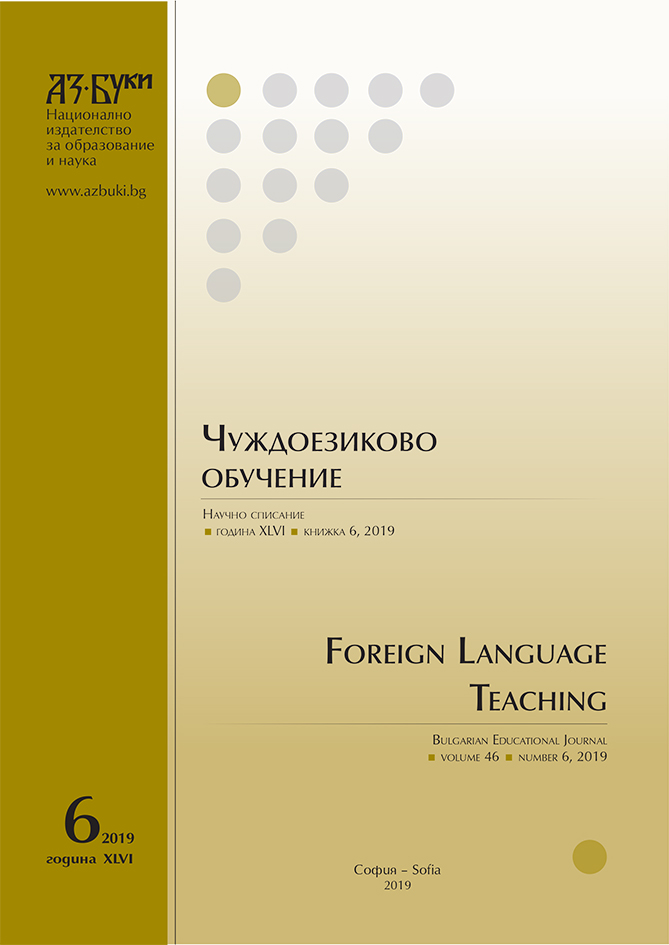
Нестор Марков и неговият принос в чуждоезиковото обучение в края на XIX и началото на XX век
The text deals with the life and activities of Nestor Markov - one of the most famous Bulgarian enlighteners after the Liberation.
More...We kindly inform you that, as long as the subject affiliation of our 300.000+ articles is in progress, you might get unsufficient or no results on your third level or second level search. In this case, please broaden your search criteria.

The text deals with the life and activities of Nestor Markov - one of the most famous Bulgarian enlighteners after the Liberation.
More...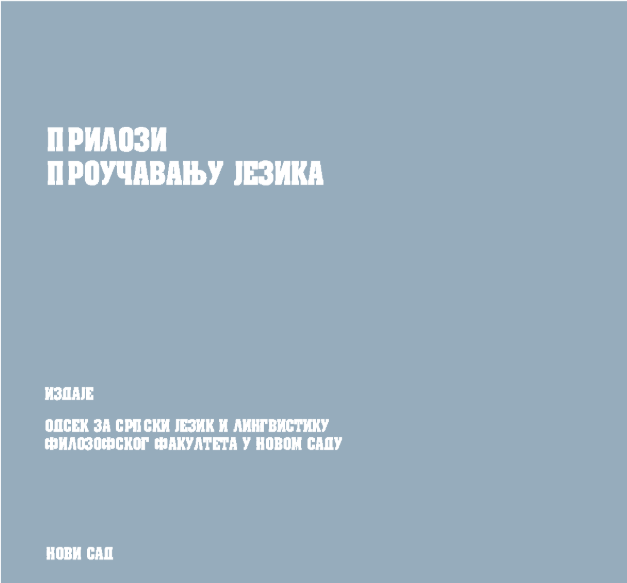
The research topic of this paper was the analysis of the translation equivalents found in the dictionary part of The Italian Grammar by Vikentije Ljuština (1794). The aim of the analysis was to determine the origin of the translation equivalents and the degree of usage of the Russian recension of Church Slavonic in the abovementioned book published at the end of the 18th century and dedicated to the Illyrian youth. Since the dictionary is divided into thematic sections, the lexemes from each section were first classified according to their semantics fields. Each semantic field was subsequently analyzed. The special focus of this research was given to the analysis of the adequacy of the translation equivalents.
More...
This paper presents a healing book with a prayer book written by Kosta Radović in 1830, which is kept in the Rarities department of Matica Srpska under the signature RR II 62. The aim of the research is to look at pre-standard language expression at the lexical level and to compose the dictionary of phytonyms represented in this manuscript. As a result, a systematic review of the herbs used for healing is obtained, as well as an overview of the language fund related to their naming. Comparison with older, medieval, medical books, such as the Hodoški zbornik and the Hilandarski tipik, seeks to shed light on the potential association of this manuscript with works of a similar purpose in the earlier period, using as criteria the organization of the text, the number and identity of the plant species, their names and medicinal actions attributed to them.
More...
The aim of this paper has been to determine the translation equivalents of passive constructions on the material of three languages, English as a language of the original text, and Serbian and Hungarian as the languages of the translation. The novel “1984“ by George Orwell was chosen as the corpora because it abounds in passive clauses, which is related to the theme and the atmosphere of a totalitarian society in which the agent is often unknown or generalized. The results of the analysis show that the thematically conditioned use of passives in the original text is reflected in the languages of the translations, which is considered non-characteristic for them, with the frequency of passive constructions being somewhat more common in Serbian than in Hungarian. Due to the characteristics of the translation languages, the translators opted for different translation solutions, which is why in the Serbian language almost equally frequent are participle and reflexive passives, while Hungarian translation is dominated by clauses with an indefinite subject and a predicate in the 3rd person plural. Deviations from the form of the original text are most evident in the translation of long passives since active sentences are the most common in both languages.
More...
This paper showcases coordinate clauses with conditionality semantics. The examples are excerpted from advertising discourse, where the first clause recommends/offers to buy a specific product or service, (in most cases using verbs ”купити“ and ”изабрати/одабрати“), while the second clause explains the consequences which always bear a positive outcome for the interlocutor, (reader or buyer), and which will set in if the recommended action of the first clause is fulfilled (in most cases using verbs ”добити (на поклон)“, ”освојити“, ”остварити (попуст)“). Those positive outcomes are the responsibility of the discourse initiator, in most cases a specific brand, and they materialize through various gifts, rewards, discounts, etc. Apart from lexical semantics of the verbs which comprise the first and second clause predicates, the paper points to the syntactic structure of these sentences: the first sentence predicate always uses imperative verb forms, while the predicate of the second is Serbian future tense type-I, or other future verb forms: present (especially for imperfective verbs) and imperative mood. Future type-I occurs in the fewest examples.
More...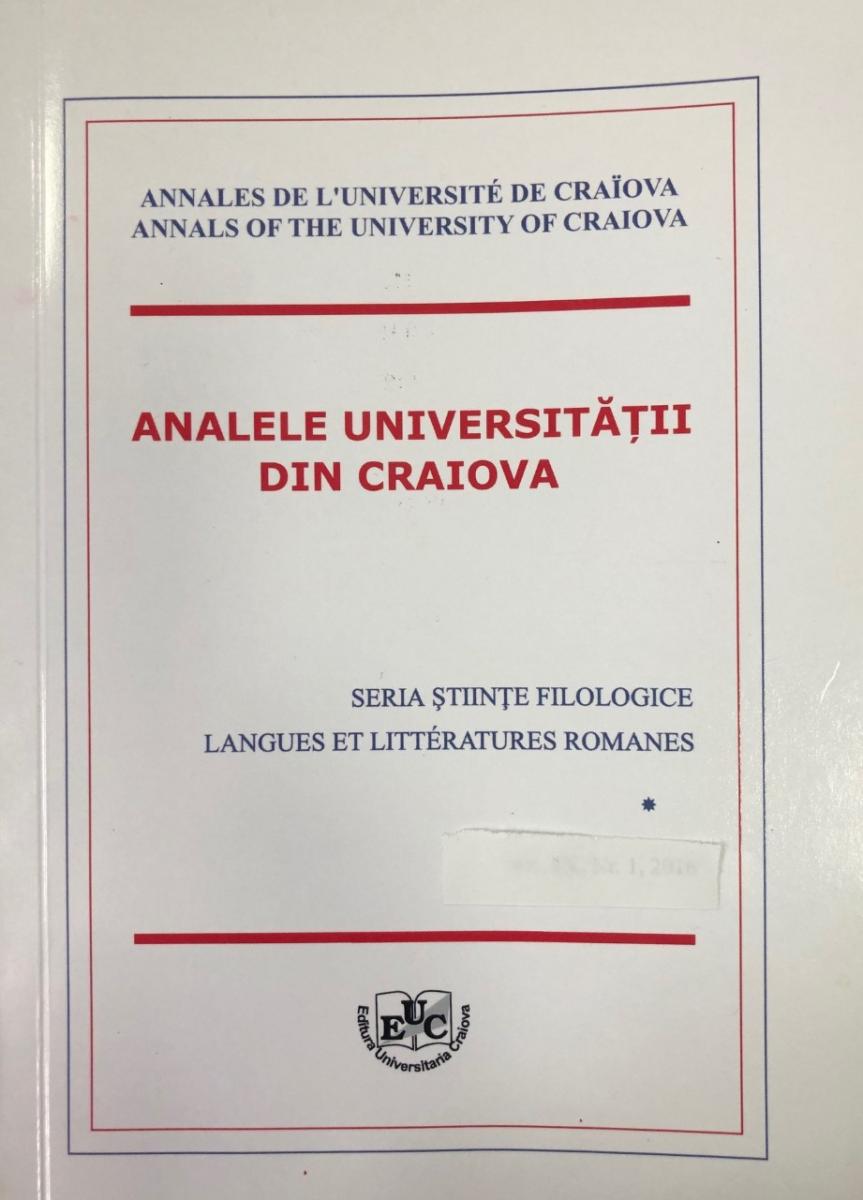
French and Spanish possess many figurative expressions of TIME, which are conceptual mappings from the source domain of SPACE. These metaphors fit into more general models described by cognitive linguistics for other languages (e.g., Lakoff and Turner 1989; Lakoff 1993; Haspelmath 1997; Yu 1998; Radden 2011). Two main theoretical approaches can be distinguished in the treatment of this conceptual metaphor: those based on universalistic apriorisms and those based on empirical studies. While the former tend to extrapolate from English, reducing this mechanism to two or three basic "natural" models (e.g., Lakoff 1993), the latter rely on "exotic" languages, whose data are more complex and often contradict theoretical (speculative) principles. This contrastive work analyzes several associative models in two widely spoken Romance languages, within the general frame of the <SPACE TO TIME> conceptual metaphor, in order to bring out additional data and arguments related with this issue.
More...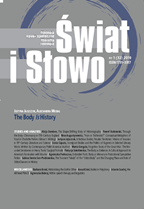
The purpose of the article is to show the Northern English dialect as a complex creation dependent on various geographical, cultural and social factors responsible for its fluidity and changeable nature. Its strong tendencies towards developing new linguistic solutions are considerably manifested in the morphological and syntactic system which since the very beginning has been subject to alternations, sometimes affecting even other English dialects. The analysis of such areas as nominal and verbal inflection, pronouns, definite articles, auxiliaries, and irregular verbs, makes it tempting to notice certain regular patterns aimed at introducing modern, more economical and thus improved linguistic models. The character and motivation of these novel creations is at times perplexing and calls for arguments not only from historical linguistics, but also geographical and perceptual dialectology as well as functional and evolutionary theories. What is beyond any doubt, however, is that as a result of those new solutions the Northern dialect has become a special sociolinguistic construct whose specific morphosyntactic makeup reveals a unique and innovative dimension defining the North both of the past and of today.
More...
The paper considers personal names in the textbooks for learning Ser- bian as a foreign language. The corpus consists of the names from A1 and A2 level textbooks. The paradigms of personal names in the textbooks are considered, and it is checked whether linguistic and cultural comments on personal names are given in the textbooks. Analytical-synthetic, descriptive, and statistical methods are applied in the study. The result confirms the hypothesis that there are no precise criteria for using personal names in Serbian language textbooks for foreign learners. In both textbooks analyzed, morphological forms of personal names rarely vary (the most commonly used case form is nominative, and none of the names is changed in all cases). Personal names are not viewed as a lexicon characterized by high cultural potential. Suggestions are proposed for improving the presentation of personal names in Ser- bian language textbooks for foreign learners. The arbitrariness associated with the selection and presentation of anthroponyms in textbooks can be eliminated if: (a) we choose common Serbian names of Christian origin; (b) we consider the personal name as a culture-bound item and (c) we choose personal names that are illustra- tive for different grammatical exercises. It is interesting to view personal names as a material for the development of grammatical and cultural competences. Namely, at the beginner level, it is essential to completely master the grammatical categories of common personal names in Serbian. Furthermore, personal names are a good starting point for the cultural framework of beginner level teaching.
More...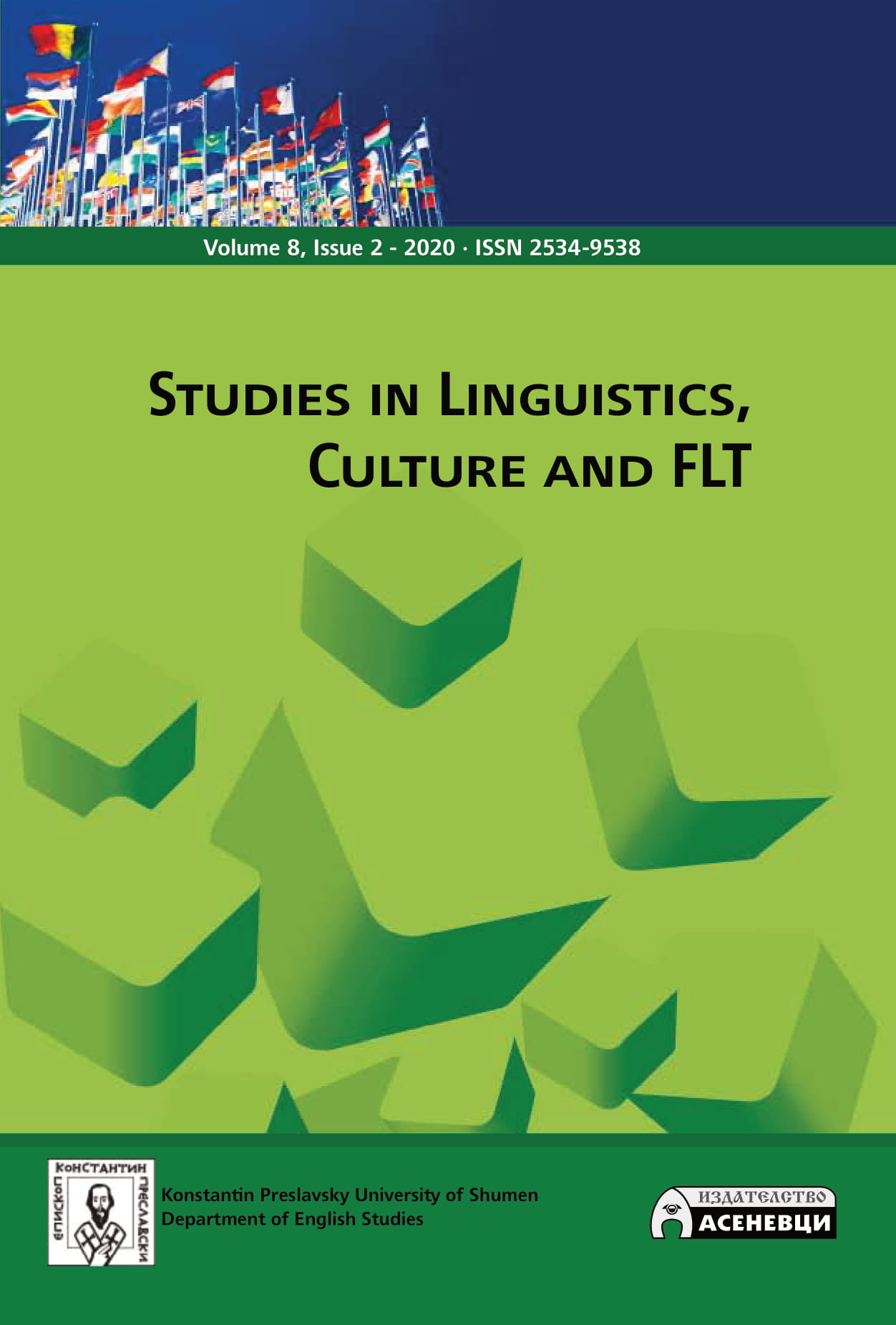
The paper presents some aspects of media presentations on a particular ethnic group which in the western psyche brings up associations with Socialism, Cold War Era, wealth, as well as of criminals, and last but not least, as the deadliest secret agents. In particular, the paper dwells on the cases of poisoning of Russian ex-spies in the UK as reflected in the media. The focus is on the way a Bulgarian, a British and a Russian newspaper present the case of the attempted murder of Sergey and Yulia Skripal with Novichok in Salisbury paying attention to the main topics put forward in the media discourse on spies. Some of the coverage of the Bulgarian trace, i.e. Emilian Gebrev, in the case is also analysed.Using CDA as the main method of analysis, the paper looks into the language used to present the whole case, the voices that get heard on the case, the focus of presentation of each media discourse along with the effect all these have on the general population. The paper argues that although articles on the topic are mostly informative and familiarize the general public with the life of spies with all its enchantment, setbacks, and negative or positive consequences, they also reveal the ongoing struggle for political dominance between today’s super powers, the existing ethnic/ national and social stereotypes, and finally stir panic, as despite some overt activities the whole activity remains largely clandestine and spies look just like normal people.
More...
Perception is universal for human beings but linguists are interested whether it is conceptualized the same way in different languages. The focus of this article is the concept of smell and how it is linguistically coded in English and Bulgarian. Such cross-linguistic meanings have not been systematically investigated when they appear in context. This study is corpus-based to capture, on the one hand, the conceptual organization of smell and, on the other hand, the structure of more abstract concepts. The study applies the cognitive perspective to interpret the conceptual metaphors in the domain of smell. The interplay of senses is used to enhance the “linguistic codability” of perceptions. Smell, which is on the whole understudied, together with touch and taste, offers a wide variety of metaphoric interpretations not only within one language but also across languages. The range of usage that is readily observable in the corpus reveals that this type of data must form the basis for empirically grounded studies of semantics. Moreover, these data suggest that cross-linguistic analogy in polysemous meanings may rely not only on universal cognition, but also on the universal experiences of social interaction.
More...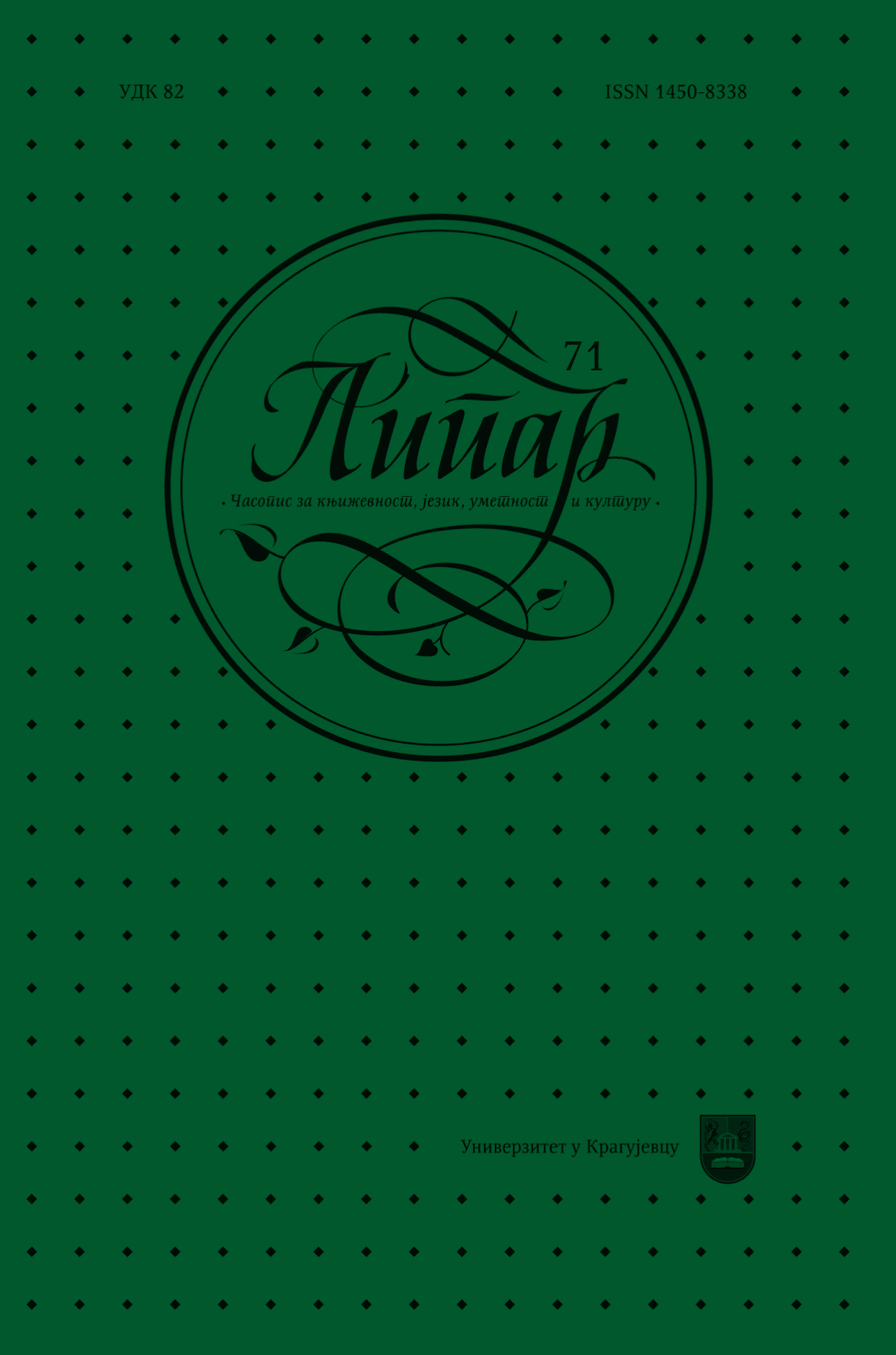
The subject of this work is to determine the ways in which students of Serbian as a foreign language, both philologists and non-philologists, construct sentences in written discourse at a beginner level. Our aim is to determine: (1) the sentence structure (simple, expanded, or compound sentences); (2) prepositional phrases of which they are comprised; (3) sentence informativeness; (4) types of word formation sentence constructions; (5) derivation of interrogative and negative sentence forms. The corpus consists of exit tests gathered at the end of the course Serbian as a foreign language at the Center for Serbian as a foreign language at the Faculty of Philology and Arts at the University of Kragujevac. The analysis of the corpus has shown that students of Serbian as a foreign language at a beginner level form simple, but informative sentences to the extent which enables them to complete basic communication processes. We will attempt to give methodical suggestions for the teaching practice which would contribute to the elimination of the errors made in the process of sentence formation, the usage of prepositional phrases, in the first place, and the process of the distribution of lexemes which comprise one sentence structure.
More...
Le sujet de l’étude est l’analyse des onomatopées dans la bande dessinée belge Les Schtroumpfs de l’auteur Pierre Culliford, ainsi que la recherche de leurs équivalents en serbe. Le corpus de cet article est basé sur les quatre volumes de la bande dessinée susmentionnée du caricaturiste Pejo, dans leur version originale en français et en serbe, traduite par Vladimir D. Janković. Dans l’article on examine les similitudes et les différences entre les onomatopées dans les deux langues, en mettant l’accent sur leur caractère graphique, ce qui permet une analyse sur le plan phonostyliste et graphostyliste par le biais d’une analyse contrastive. Les résultats de la recherche montrent qu’il est possible de traduire des onomatopées de la langue source dans la langue cible par l’opération du transcodage, mais qu’il faut tenir en compte la liberté relative du traducteur dans la stylisation des onomatopées
More...
The aim of this research is to perform the analysis of idioms containing the lexeme water in Serbian and English language. The goal was to confirm whether, and to what degree, these two languages show similarity in the lexical sense and to identify possible subtle differences in meaning that certain varieties of an idiom give rise to, which we sought to discover by conducting the semantic analysis of the examples extracted from the dictionaries. The research concluded that there are no major differences in the two languages regarding the semantic meaning overall, since we find the same categories into which these idioms can be classified. Regarding the varieties, differences are noticed only in a small number of Serbian idioms.
More...
This paper analyzes the significance of the application of forensic phonetics in investigative and judicial processes, i.e. the application of the language knowledge in order to solve various criminal actions and litigations. The aim is to determine, based on the available literature in which manner and extent the forensic practice of identity recognition based on voice is represented in the judiciary. The basic frames of forensic expert analysis in the field of determining the person based on voice are presented. The concept of identity in criminalistics is indicated, as well as the eviden- tial value of the results of the expert analysis in the speaker’s recognition. The final results of the forensic expert analysis, expressed in a scale of ranged probabilities, are considered. Requirement and possibility of using the voice in various types and stages of police procedures, criminal investigation or criminal proceedings are indicated.
More...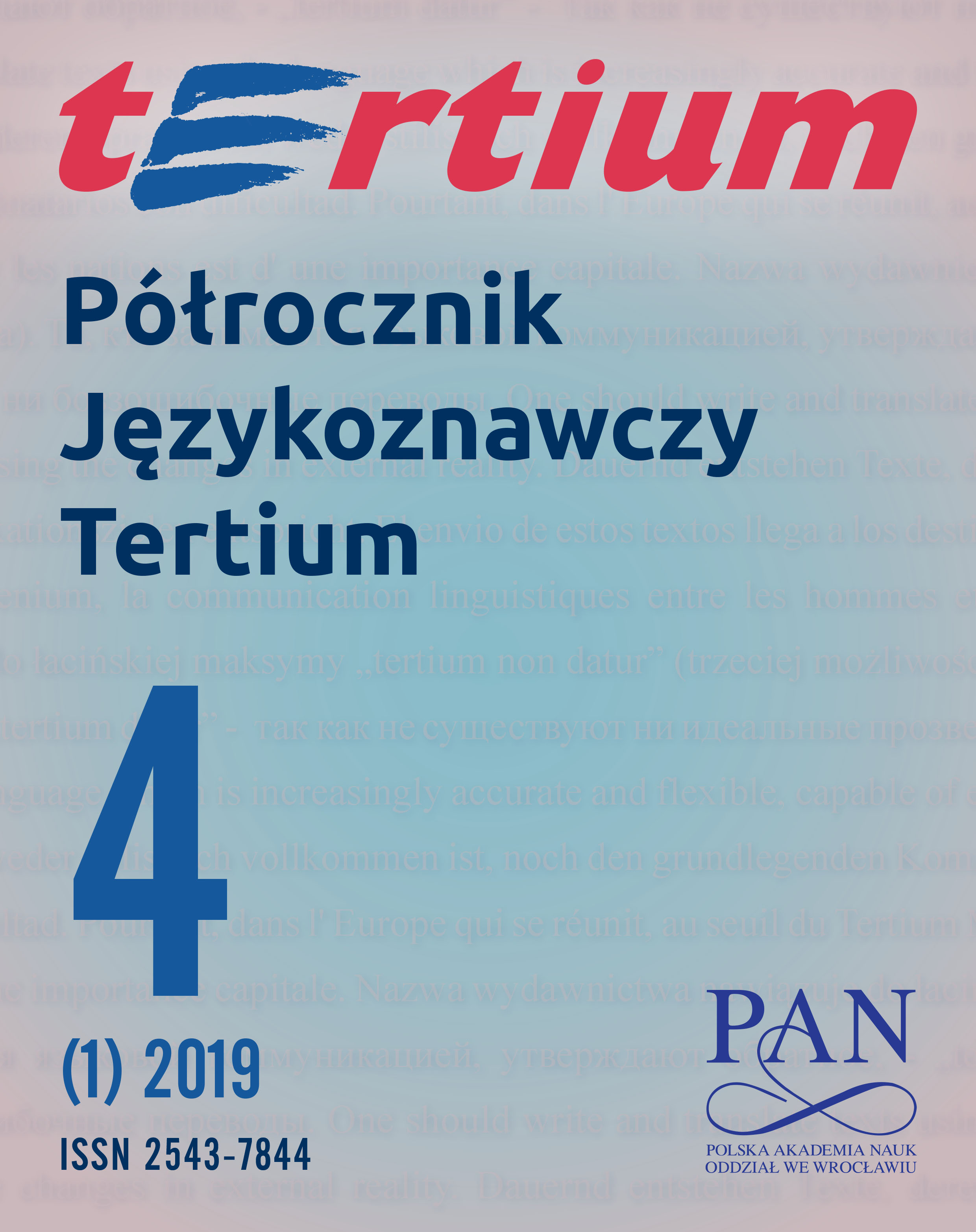
The article is a part of a more extensive linguistic project exploring the concept of ‘empathy’ and its exponents in the present-day Polish (Falkowska 2012, 2017, 2018). The analysis is based on a corpus compiled out of Polish media texts concerning the tragic Nanga Parbat expedition (January 2018). Selected Internet posts and social media comments have also been included. I focus on empathy understood along the lines set by Kuno (1987), i.e. the speaker’s identification with one of the scene’s participants, and I aim at depicting the linguistic means that are applied in order to communicate the speaker’s empathy towards a scene participant. The study employs Langacker’s Cognitive Grammar model (1987, 2009) and the cognitive discourse analysis framework (Hart 2014), with special reference to the notions of empathy, empathy hierarchy and point of view.
More...
The aim of the present paper, which is of a theoretical character, is to discuss the problems related to the process of the compilation of one’s own linguistic corpus. A linguist who wants to study e.g. neologisms must base his or her analysis on a certain source. Formerly, the language of the press was frequently used as such source; now, however, linguistic corpora and the Internet are utilized more frequently. The author of the paper points out that both the National Corpus of Polish (NKJP) and the Internet as a whole are not the best choices (and are definitely not sufficient) when a linguist intends to study e.g. the newest vocabulary items in Polish. The use of the spoken language as the main source is even more problematic. The best solution, albeit the most difficult and time-consuming at the same time, is the compilation of one’s own linguistic corpus. The paper discusses the inadequacy of regarding the press or the Internet as a whole as the best sources and then proceeds to discuss various theoretical aspects connected with the compilation of one’s own corpus (such as the choice of the type of texts, corpus size, the use of computer tools intended to aid in corpus compilation, etc.).
More...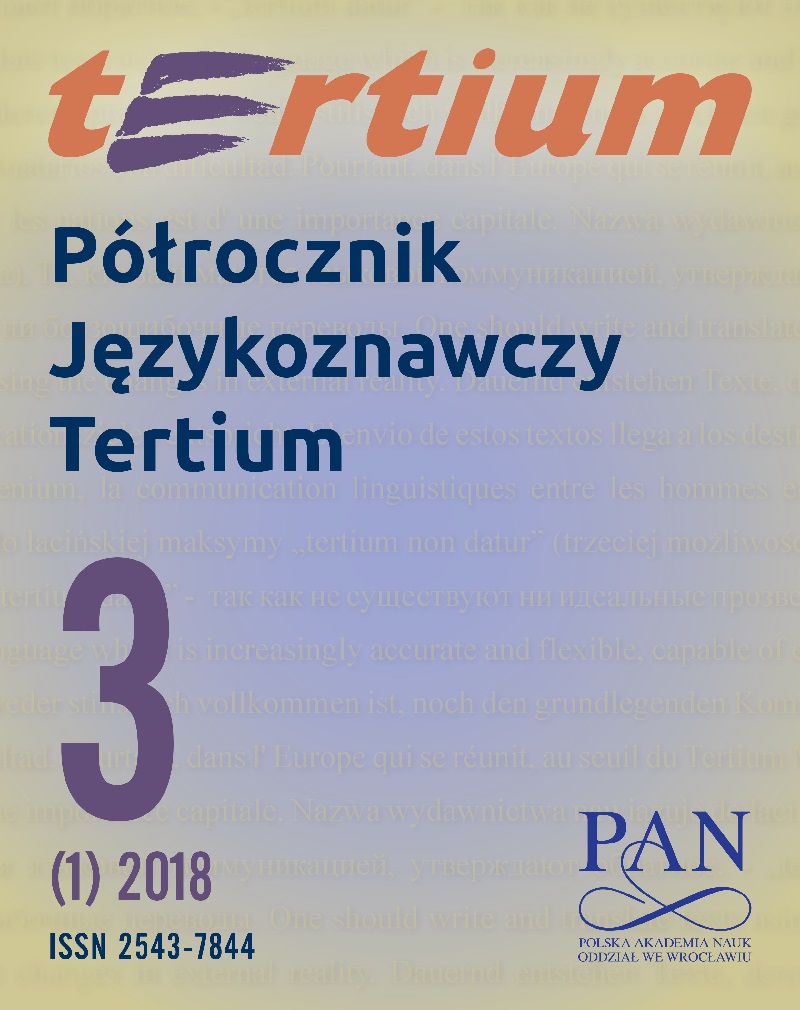
Artykuł stanowi próbę odpowiedzi na postawione w tytule pytanie. Puntem wyjścia jest przegląd językoznawczych koncepcji gatunku mowy o nachyleniu strukturalnym, funkcjonalnym, wreszcie kognitywnym oraz próba odniesienia kognitywnej koncepcji prototypu Ronalda Langackera do wyżej wymienionych ujęć wyrosłych na gruncie polskiej tekstologii. Jako egzemplifikacja analizowanych koncepcji gatunku służą dwie współczesne wersje o Kopciuszku. Na ich przykładzie autorzy starają się odpowiedzieć na pytanie, dlaczego należą do gatunku bajki w świetle przywoływanych koncepcji oraz co nowego, w zakresie genologii, przynieść może aplikacja koncepcji Ronalda Langackera. // The article revolves around the title question, starting with a brief overview of the major accounts of what the speech genre can possibly be in structurally, functionally-, and, finally, cognitively-oriented accounts. The latter are identified specifically with Ronald Langacker’s understanding of the prototype, and are here related/compared to the conceptions in selected Polish genre studies. The material basis and the source of exemplification are found in two modern versions of the Cinderella story. The main bulk of argumentation has to do with the research question of why, how, and to what extent these two modern versions can still be considered a Cinderella tale in the light of the respective accounts, and what new perspectives Langacker’s conception of the prototype can bring if applied to speech genre studies.
More...
Przedmiotem artykułu jest omówienie powstającego w ramach projektu badawczego polsko-niemieckiego słownika językowego savoir-vivre’u. Przedstawione zostały założenia leksykograficzne tego słownika, źródło materiału oraz struktura hasła. Główny problem badawczy to niemiecka ekwiwalencja funkcjonalna polskich zwrotów grzecznościowych. Metodologia badań oparta jest na założeniach pragmatyki kulturowej. Autorka skupiła się na omówieniu podstawowych różnic przede wszystkim kulturowych i pragmatycznojęzykowych między polską i niemiecką grzecznością językową. Omówione zostały takie problemy, jak: różne w polszczyźnie i w niemczyźnie strategie grzecznościowe, w tym polska strategia podwładnego i strategia męskiej kurtuazji; polski i niemiecki system adresatywny; możliwość stopniowania uprzejmości w polskich aktach prośby i częstowania oraz problem niemieckiej ekwiwalencji; wpływ czynników społeczno-politycznych na funkcjonowanie form adresatywnych. Wskazano na taki dodatkowy rezultat powstania słownika, jak możliwość zrekonstruowania na jego podstawie obrazu uprzejmego Polaka i uprzejmego Niemca. Na zakończenie została sformułowana teza, że powstawanie tego typu dwujęzycznych (dwukulturowych) słowników miałoby wpływ na zoptymalizowanie komunikacji międzykulturowej. // This paper discusses a Polish-German savoir-faire dictionary, which is currently being created as part of a research project. The author presents the lexicographic framework, the source material and the structure of the entries. The main analytical problem is the German functional equivalence of Polish politeness expressions. The methodology is based on the assumptions of cultural pragmatics. The author focuses on the basic, mainly cultural and pragmalinguistic differences between Polish and German linguistic politeness. The paper discusses the following issues: the differences in Polish and German politeness strategies, including the Polish strategy of the subordinate and the strategy of male courtesy; Polish and German honorific systems; the possibility of grading politeness in the Polish speech acts of request and the offering of food as well as the problem of German equivalence; the influence of socio-political factors on the functioning of the honorific forms. The author points out that the creation of this dictionary opens up the possibility of reconstructing the notions of a polite Pole and a polite German. Finally, the author formulates the thesis that the creation of this type of bilingual (bicultural) dictionaries may result in the optimisation of intercultural communication.
More...
Effective opinion writing should present the author’s viewpoint in a convincing way but also engage the reader. Whether the author makes more references to their own viewpoints or to the reader is determined by the context of the text. Metadiscourse is a pragmatic framework of explicit linguistic devices used to make references to the reader, the writer and their evaluations, as well as references to the textual organisation. This paper employs the corpus-driven method called Multi-Dimensional Analysis to study statistically significant correlation patterns between metadiscourse markers. Four patterns emerge from a specialized corpus of opinion writing online in English by (semi-)professional writers (285,000 words). The patterns are interpreted as representing writers’ strategies to define the relationship between themselves, the reader and the topic. While there are some overlaps and cross-genre tendencies, the use of metadiscourse is to some extent determined by the prevailing norms of the sub-genre of the text – here, whether the publication platform is a blog, a news site, or the website of a print-newspaper. Blogs tend to use a writer-oriented strategy with more self-mentions, and news sites a reader-oriented strategy or a solidarity strategy uniting the reader and writer under a shared “we”-pronoun. The results of the study may be of value both in understanding the journalistic online genres and for the development of the metadiscourse framework.
More...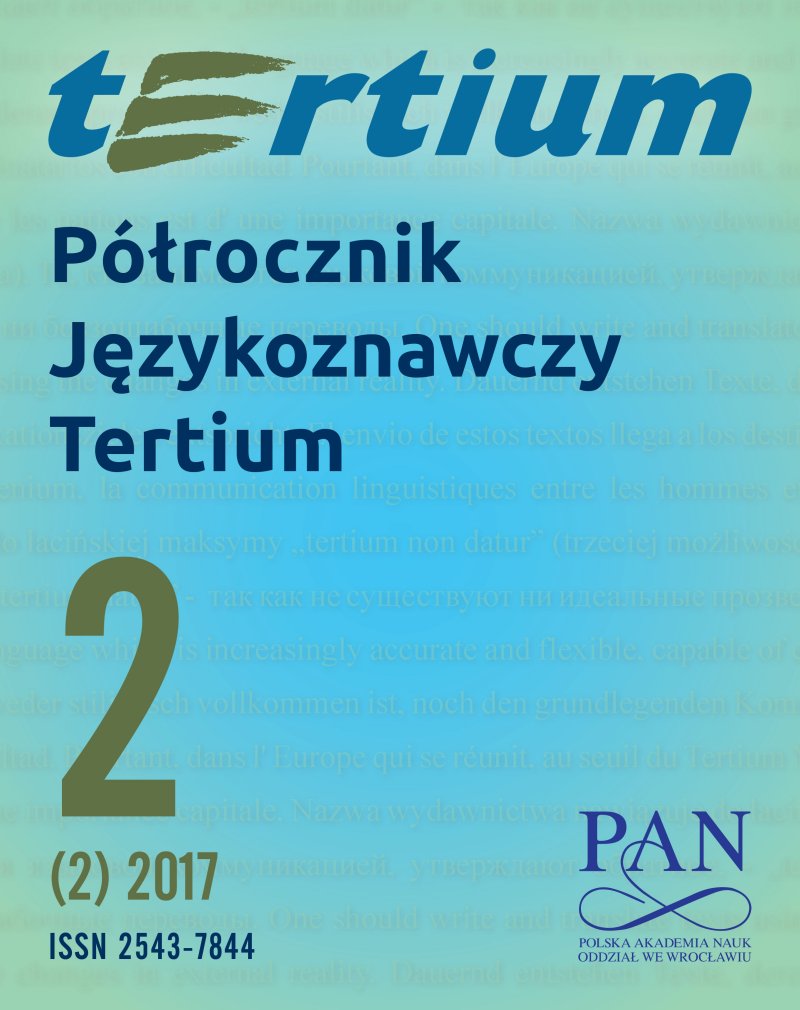
Artykuł podejmuje temat językowych reprezentacji kulturowej odmienności w literaturze szwedzkiej, przedstawiającej środowiska imigranckie i/lub rozwarstwione klasowo. Język, zarówno protagonistów jak i narracji, jest konstruktem literackim, który eksponuje jedynie niektóre elementy językowe (głównie leksykalne) jako relewantne dla osiągnięcia pragmatycznego celu – efektu obcości. Przedmiotem artykułu jest analiza stylistyczna zastosowanych środków oraz strategie tłumaczy zmierzające do uzyskania ekwiwalencji funkcjonalnej. // The article takes up the problem of linguistic representations of cultural otherness in Swedish literature featuring immigrant and/or class-stratified environments. The language, both of the protagonists as well as the narration, is a literary construct exposing only those linguistic elements (mainly lexical ones) which are relevant for achieving a pragmatic purpose – the effect of otherness. The article presents a stylistic analysis of the means of expression employed together with translators' strategies aimed at achieving a functional equivalence.
More...